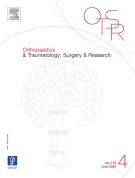The use of the anterior tendinous portion of the supraspinatus muscle as a central point for rotator cuff repair - 03/04/25
 , Lucie Schnedecker c, Bouchra Assabah d, e, Nguyen Tran f, François Sirveaux a, f, Adrien Jacquot b, g
, Lucie Schnedecker c, Bouchra Assabah d, e, Nguyen Tran f, François Sirveaux a, f, Adrien Jacquot b, gAbstract |
Introduction |
Double-row repairs with knots on the medial row carry a risk of secondary lesions at the myotendinous junction. Knotless double-row repairs imply dependence between rows, sometimes resulting in a failure to properly apply the medial row, and the systematic use of 4 anchors. The anterior tendinous portion of the supraspinatus muscle appears to be a promising anatomical landmark and support point for the medial row in an optimized independent double-row technique.
Hypothesis |
This technique provides results equivalent to those published about rotator cuff repair and reduces the risk of medial secondary rupture and the number of implants used.
Materials and methods |
This study includes an initial histopathological analysis of the supraspinatus muscle, complemented by an in vivo arthroscopic observation of its anterior tendinous portion in a consecutive series of arthroscopy procedures on shoulders with intact rotator cuffs. We present a technique for independent double-row repair using 2 (or 3) anchors, with a single knot on the medial row relying on the anterior tendinous portion of the supraspinatus muscle, and lateral tension-band sutures. In this study, we report the clinical and ultrasound outcomes from a preliminary prospective series of 20 patients with distal supraspinatus tears at a 2-year follow-up.
Results |
The anterior tendinous portion of the supraspinatus was found in 100% of patients in our arthroscopic analysis. Regarding the surgical technique, the median number of anchors was 2. At 2-year follow-ups, the median Constant score was 84.5, and the Subjective Shoulder Value score was 93%. No complications were recorded. Tendon healing was achieved in 100% of cases (Sugaya stage I or II).
Conclusion |
This independent double-row repair technique relying on the anterior tendinous portion of the supraspinatus muscle provides a solid medial row fixation, minimizing the risk of secondary myotendinous injury, and an appropriate anatomical landmark, allowing for a more anatomic repair. It is a simple and reproducible technique requiring a limited number of implants and demonstrating satisfactory clinical outcomes and tendon healing rate.
Level of evidence |
IV.
Le texte complet de cet article est disponible en PDF.Keywords : Shoulder arthroscopy, Double row, Cuff tear
Plan
Bienvenue sur EM-consulte, la référence des professionnels de santé.
L’accès au texte intégral de cet article nécessite un abonnement.
Déjà abonné à cette revue ?

